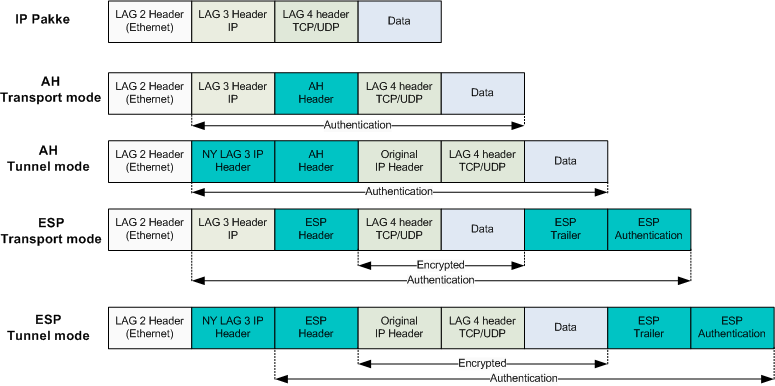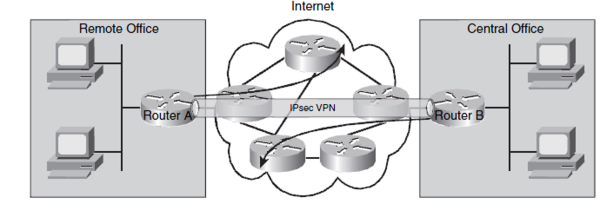Difference between revisions of "IPsec Cisco IOS"
m (→IPsec modes) |
m (→IPsec Site-to-Site configuration steps) |
||
| Line 38: | Line 38: | ||
#Tunnel termination | #Tunnel termination | ||
== IPsec Site-to-Site configuration steps == | == IPsec Site-to-Site configuration steps == | ||
| − | + | * 1:Configure ISAKMP policy (IKE phase 1) | |
<source lang=cli> | <source lang=cli> | ||
crypto isakmp policy 10 | crypto isakmp policy 10 | ||
| Line 47: | Line 47: | ||
lifetime 3600 | lifetime 3600 | ||
</source> | </source> | ||
| − | + | * 2: Configure the IPsec transform set (IKE phase 2 and tunnel termination) | |
<source lang=cli> | <source lang=cli> | ||
crypto ipsec transform-set 50 esp-aes 256 esp-sha-hmac ah-sha-hmac | crypto ipsec transform-set 50 esp-aes 256 esp-sha-hmac ah-sha-hmac | ||
exit | exit | ||
</source> | </source> | ||
| − | + | * 3: Configure Crypto ACL (Specifying interesting traffic which go through the secure channel) | |
<source lang=cli> | <source lang=cli> | ||
access-list 101 permit ip 172.16.1.0 0.0.0.255 172.16.3.0 0.0.0.255 | access-list 101 permit ip 172.16.1.0 0.0.0.255 172.16.3.0 0.0.0.255 | ||
</source> | </source> | ||
| − | + | * 4: Configure the Crypto map (IKE phase 2) | |
<source lang=cli> | <source lang=cli> | ||
crypto map MYMAP 10 ipsec-isakmp | crypto map MYMAP 10 ipsec-isakmp | ||
| Line 64: | Line 64: | ||
set security-association lifetime seconds 900 | set security-association lifetime seconds 900 | ||
</source> | </source> | ||
| − | + | * 5: Apply the crypto map to the interface (IKE phase 2) | |
<source lang=cli> | <source lang=cli> | ||
interface fastethernet0/0 | interface fastethernet0/0 | ||
| Line 70: | Line 70: | ||
crypto map MYMAP | crypto map MYMAP | ||
</source> | </source> | ||
| − | + | * 6: Configure the interface ACL. | |
Permit IPsec to go through. | Permit IPsec to go through. | ||
<source lang=cli> | <source lang=cli> | ||
| Line 80: | Line 80: | ||
ip access-group 110 in | ip access-group 110 in | ||
</source> | </source> | ||
| − | |||
== IPsec modes == | == IPsec modes == | ||
Revision as of 10:22, 10 August 2009
Contents
IPsec muligheder
- IPsec—Internet Protocol Security (IPsec) is a suite of protocols that can provide data confidentiality, data integrity, and data origin authentication to IP packets.
- Internet Key Exchange (IKE)—A framework used to exchange security parameters and authentication keys between IPsec endpoints.
- Encryption Algorithms—Mathematical algorithms (and the associated keys) used to make data unreadable to everyone except those who have the proper keying material.
- Public Key Infrastructure—A hierarchical framework for managing the security attributes for devices that engage in secure communications across a network.
IPsec protokoller
IPsec consists of three primary protocols to help implement the overall IPsec architecture:
- Internet Key Exchange (IKE)
- Encapsulating Security Payload (ESP)
- Authentication Header (AH)
Together, these three protocols offer the various IPsec features mentioned earlier. Every IPsec VPN uses some combination of these protocols to provide the desired features for the VPN.
IKE
Internet Key Exchange (IKE) is a framework for the negotiation and exchange of security parameters and authentication keys. The IPsec security parameters will be examined later in the “Internet Key Exchange (IKE)” section. For now, it is important to understand that there are a variety of possible options between two IPsec VPN endpoints. The secure negotiation of these parameters used to establish the IPsec VPN characteristics is performed by IKE. IKE also exchanges keys used for the symmetrical encryption algorithms within an IPsec VPN. Compared to other encryption algorithms, symmetrical algorithms tend to be more efficient and easier to implement in hardware. The use of such algorithms requires appropriate key material, and IKE provides the mechanism to exchange the keys.
ESP
Encapsulating Security Payload (ESP) provides the framework for the data confidentiality, data integrity, data origin authentication, and optional anti-replay features of IPsec. While ESP is the only IPsec protocol that provides data encryption, it also can provide all of the IPsec features mentioned earlier. Because of this, ESP is primarily used in IPsec VPNs today. The following encryption methods are available to IPsec ESP:
- Data Encryption Standard (DES)—An older method of encrypting information that has enjoyed widespread use.
- Triple Data Encryption Standard (3DES)—A block cipher that uses DES three times.
- Advanced Encryption Standard (AES)—One of the most popular symmetric key algorithms used today.
AH
Authentication Header (AH) provides the framework for the data integrity, data origin authentication, and optional anti-replay features of IPsec. Note that data confidentiality is not provided by AH. AH ensures that the data has not been modified or tampered with, but does not hide the data from inquisitive eyes during transit. As such, the use of AH alone in today’s networks has faded in favor of ESP. Both AH and ESP use a Hash-based Message Authentication Code (HMAC) as the authentication and integrity check. Table below shows the HMAC hash algorithms in IPsec.
| Hash Algorithm | input | Output | User by IPsec |
|---|---|---|---|
| Message Digest 5(MD5) | Variable | 128 bits | 128 bits |
| Secure hash Algorithm (SHA-1) | Variable | 160 bits | First 96 bits |
Both MD5 and SHA-1 use a shared secret key for both the calculation and verification of the message authentication values. The cryptographic strength of the HMAC is dependent upon the properties of the underlying hash function. Both MD5 and SHA-1 take variable-length input data and create a fixed-length hash. The difference is the size and strength of the hash created. Although IPsec uses only the first 96 bits of the 160-bit SHA-1 hash, it is considered more secure than MD5 (although SHA-1 is computationally slower than MD5).
IPsec operation
- Interesting traffic discovered (ACL list)
- IKE phase 1 (Security negotiation and establish secure communication channel)
- IKE phase 2 (Establishing the tunnel negotiate IPsec transform set and establish and maintain tunnel)
- Secure data transfer (IKE phase 2 renegoitiate keys at intervals)
- Tunnel termination
IPsec Site-to-Site configuration steps
- 1:Configure ISAKMP policy (IKE phase 1)
crypto isakmp policy 10
authentication pre-share
encryption aes 256
hash sha
group 5
lifetime 3600- 2: Configure the IPsec transform set (IKE phase 2 and tunnel termination)
crypto ipsec transform-set 50 esp-aes 256 esp-sha-hmac ah-sha-hmac
exit- 3: Configure Crypto ACL (Specifying interesting traffic which go through the secure channel)
access-list 101 permit ip 172.16.1.0 0.0.0.255 172.16.3.0 0.0.0.255- 4: Configure the Crypto map (IKE phase 2)
crypto map MYMAP 10 ipsec-isakmp
match address 101
set peer 80.1.2.3
set transform-set 50
set security-association lifetime seconds 900- 5: Apply the crypto map to the interface (IKE phase 2)
interface fastethernet0/0
ip address 90.2.3.4 255.255.255.0
crypto map MYMAP- 6: Configure the interface ACL.
Permit IPsec to go through.
access-list 110 permit ahp host 80.1.2.3 host 90.2.3.4
access-list 110 permit esp host 80.1.2.3 host 90.2.3.4
access-list 110 permit udp host 80.1.2.3 host 90.2.3.4 eq isakmp
!
interface fastethernet0/0
ip access-group 110 inIPsec modes
Eksempler
Site-to-Site VPN
Before configuring IPsec make sure you can ping between the Routers.You must be able to ping the two endpoints of the tunnel. In the example below R1 endpoint is 192.168.100.103 on fastethernet 0/0 and R2 endpoint is 192.168.100.104 on fastethernet 0/0. The configuration Tunnels all trafic between 172.16.1.0/24 on R1 and 172.16.3.0/24 on R2. |
R1 config
hostname R1
!
interface loopback 0
ip address 172.16.1.1 255.255.255.0
!
router rip
version 2
network 172.16.1.0
!
crypto isakmp enable
!
crypto isakmp policy 10
authentication pre-share
encryption aes 256
hash sha
group 5
lifetime 3600
!
crypto isakmp key cisco address 192.168.100.104
!
crypto ipsec transform-set 50 esp-aes 256 esp-sha-hmac ah-sha-hmac
exit
!
crypto ipsec security-association lifetime seconds 1800
!
access-list 101 permit ip 172.16.1.0 0.0.0.255 172.16.3.0 0.0.0.255
!
crypto map MYMAP 10 ipsec-isakmp
match address 101
set peer 192.168.100.104
set pfs group5
set transform-set 50
set security-association lifetime seconds 900
!
interface fastethernet0/0
ip address 192.168.100.103 255.255.255.0
crypto map MYMAPR2 Config
hostname R2
!
interface loopback 0
ip address 172.16.3.1 255.255.255.0
!
router rip
version 2
network 172.16.3.0
network 192.168.100.0
!
crypto isakmp enable
!
crypto isakmp policy 10
authentication pre-share
encryption aes 256
hash sha
group 5
lifetime 3600
!
crypto isakmp key cisco address 192.168.100.103
!
crypto ipsec transform-set 50 esp-aes 256 esp-sha-hmac ah-sha-hmac
exit
!
crypto ipsec security-association lifetime seconds 1800
!
access-list 101 permit ip 172.16.3.0 0.0.0.255 172.16.1.0 0.0.0.255
!
crypto map MYMAP 10 ipsec-isakmp
match address 101
set peer 192.168.100.103
set pfs group5
set transform-set 50
set security-association lifetime seconds 900
!
interface fastethernet0/0
ip address 192.168.100.104 255.255.255.0
crypto map MYMAPchecking tunnel
R1#<input>show crypto isakmp policy</input>
Global IKE policy
Protection suite of priority 10
encryption algorithm: AES - Advanced Encryption Standard (256 bit keys).
hash algorithm: Secure Hash Standard
authentication method: Pre-Shared Key
Diffie-Hellman group: #5 (1536 bit)
lifetime: 3600 seconds, no volume limit
Default protection suite
encryption algorithm: DES - Data Encryption Standard (56 bit keys).
hash algorithm: Secure Hash Standard
authentication method: Rivest-Shamir-Adleman Signature
Diffie-Hellman group: #1 (768 bit)
lifetime: 86400 seconds, no volume limit
R1#<input>show crypto ipsec transform-set</input>
Transform set 50: { ah-sha-hmac }
will negotiate = { Tunnel, },
{ esp-256-aes esp-sha-hmac }
will negotiate = { Tunnel, },
R1#show crypto map
Crypto Map "MYMAP" 10 ipsec-isakmp
Peer = 192.168.100.104
Extended IP access list 101
access-list 101 permit ip 172.16.1.0 0.0.0.255 172.16.3.0 0.0.0.255
Current peer: 192.168.100.104
Security association lifetime: 4608000 kilobytes/900 seconds
PFS (Y/N): Y
DH group: group5
Transform sets={
50,
}
Interfaces using crypto map MYMAP:
FastEthernet0/0Sending some test packets from 172.16.1.1 to 172.16.3.1
C1#<input>ping 172.16.3.1 source 172.16.1.1</input>
Sending 5, 100-byte ICMP Echos to 172.16.3.1, timeout is 2 seconds:
Packet sent with a source address of 172.16.1.1
.!!!!
Success rate is 80 percent (4/5), round-trip min/avg/max = 1/2/4 ms
C1#<input>show crypto ipsec sa</input>
interface: FastEthernet0/0.1
Crypto map tag: MYMAP, local addr 192.168.100.103
protected vrf: (none)
local ident (addr/mask/prot/port): (172.16.1.0/255.255.255.0/0/0)
remote ident (addr/mask/prot/port): (172.16.3.0/255.255.255.0/0/0)
current_peer 192.168.100.104 port 500
PERMIT, flags={origin_is_acl,ipsec_sa_request_sent}
<notice>#pkts encaps: 4, #pkts encrypt: 4, #pkts digest: 4
#pkts decaps: 4, #pkts decrypt: 4, #pkts verify: 4</notice>
#pkts compressed: 0, #pkts decompressed: 0
#pkts not compressed: 0, #pkts compr. failed: 0
#pkts not decompressed: 0, #pkts decompress failed: 0
#send errors 1, #recv errors 0
local crypto endpt.: 192.168.100.103, remote crypto endpt.: 192.168.100.104
path mtu 1500, ip mtu 1500, ip mtu idb FastEthernet0/0.1
current outbound spi: 0x521B43F6(1377518582)
inbound esp sas:
spi: 0x92A7A6F8(2460460792)
transform: esp-256-aes esp-sha-hmac ,
in use settings ={Tunnel, }
conn id: 2001, flow_id: FPGA:1, crypto map: MYMAP
sa timing: remaining key lifetime (k/sec): (4400183/893)
IV size: 16 bytes
replay detection support: Y
<notice>Status: ACTIVE</notice>
inbound ah sas:
spi: 0xFE07354B(4261885259)
transform: ah-sha-hmac ,
in use settings ={Tunnel, }
conn id: 2001, flow_id: FPGA:1, crypto map: MYMAP
sa timing: remaining key lifetime (k/sec): (4400183/887)
replay detection support: Y
<notice>Status: ACTIVE</notice>
inbound pcp sas:
outbound esp sas:
spi: 0x521B43F6(1377518582)
transform: esp-256-aes esp-sha-hmac ,
in use settings ={Tunnel, }
conn id: 2002, flow_id: FPGA:2, crypto map: MYMAP
sa timing: remaining key lifetime (k/sec): (4400183/887)
IV size: 16 bytes
replay detection support: Y
<notice>Status: ACTIVE</notice>
outbound ah sas:
spi: 0xB6D629E1(3067488737)
transform: ah-sha-hmac ,
in use settings ={Tunnel, }
conn id: 2002, flow_id: FPGA:2, crypto map: MYMAP
sa timing: remaining key lifetime (k/sec): (4400183/886)
replay detection support: Y
<notice>Status: ACTIVE</notice>
outbound pcp sas:
